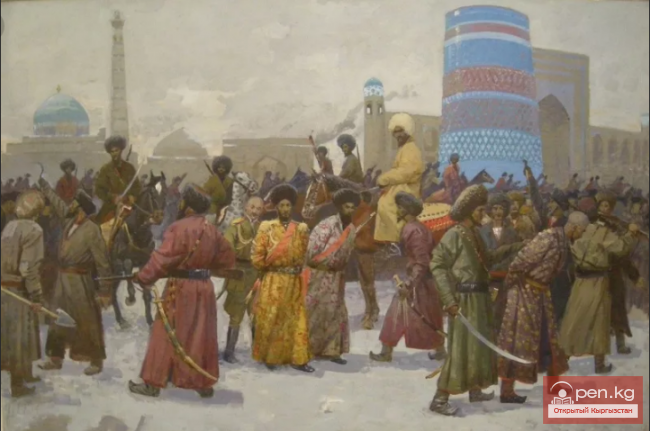Colonial Authority Against the Rebels
A larger uprising occurred in the mountainous region of Andijan County, populated by Kyrgyz people. The number of participants exceeded 1,000. The rebels did not have a single leader and consisted of several groups, each of which numbered 200-300 people.
The participants of the uprising were armed with clubs (sticks), spears, and partially with rifles and pistols. As noted in an official archival document, the rebels found live support from the local population of the mentioned county and were fed food delivered to them by local residents. However, this spontaneous uprising did not have the chance to gain widespread momentum.
It was suppressed by a tsarist punitive detachment consisting of 150 Cossacks, 400 soldiers, and officers.
The tsarist colonial authority, trying to instill fear in the local population, to teach them a strong lesson and break their free-spirited spirit, drowned the Andijan uprising in blood. The areas affected by the uprising were flooded with tsarist punitive detachments. Military units from the Fergana, Syr-Darya, and Semirechye regions and the city of Tashkent were involved in suppressing the uprising. On May 20, in the village of Charvak, located more than 90 km east of the city of Andijan, Madali Ishan was captured. A total of 777 people were arrested, of whom 415 were brought to trial. 371 people languished behind bars.
Tsarist prisons in the cities of the Fergana region became overcrowded with arrested rebels. Here’s what was said about this in the report of the Turkestan Governor-General dated August 3, 1898: "In Andijan, as in Osh, the places of detention soon became overcrowded." In suppressing the uprising in question and capturing its participants, the tsarist punitive forces received significant assistance from representatives of the local feudal nobility, especially those who were in the service of the colonial authority. The same Turkestan Governor-General emphasized in the mentioned report that "the local administration officials significantly assisted in the capture of the rebels." Several local feudal lords served as guides for the tsarist punitive detachments, and some of them personally, with their horsemen, caught rebels and handed them over to the colonial authorities.
On June 12 of that year, Madali Ishan and his associates: Mulla-Gaib-Nazar-Artik-oglu, Subhankul-Arabbai-oglu, Rustambek-Satubaldybek-oglu, Mirza-Khamdam-Usmanbay-oglu, and Babatai-Gainambai-oglu were executed by hanging. The same fate befell another 12 active participants of the uprising. 362 people were exiled to hard labor, of which 18 were sent to Siberia.
The brutality of the tsarist authority in suppressing the uprising in question knew no bounds. Min-Tyube, Kashgar, Don, Naurat, and some other villages through which the participants of the uprising passed were wiped off the face of the earth, and their inhabitants were evicted beyond the borders of the region. The areas of these villages were plowed, leveled, and included in the resettlement fund.
The colonial authority, frightened by the popular uprising, declared the Fergana, Syr-Darya, and Samarkand regions to be in a state of heightened security and hastily began arming resettlers with Berdan rifles and other firearms. In this way, it sought to pit Russian settlers against the local labor population to dull, and if possible, silence the struggle of the working people against the tsarist autocracy. Violators of the heightened security regime were subject to arrest for up to one month or a monetary fine of 30 rubles. This played into the hands of tsarist officials, who harshly punished local workers for the slightest disobedience and ruthlessly dealt with those they deemed undesirable.
The Andijan Uprising in May 1898












































